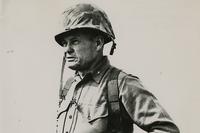In the military, the "high and tight" reigns supreme by today's hair regulation standards, but in the civilian world, the mullet is making a comeback. Once universally accepted as the most reviled haircut on Earth, the COVID-19 pandemic has resurrected the style, with some even declaring 2020 as "The Year of the Mullet."
It's highly unlikely that the mullet will be making its way back into the good graces of military uniform regulations, but in the days of yore, it was (apparently) the perfect look for anyone about to walk into combat.
From the earliest days of military history, warriors have been rocking the mullet. There was no "business in the front, party in the rear" when Homer described the Abantes, a unit of Greek spearmen in "The Iliad," when they sailed for Troy in 40 long, black ships. Instead, Homer described their hair with the immortal line, "their forelocks cropped, hair grown long at the backs."
Hair historian Rachael Gibson agrees. In a 2021 web video on the history of this hairstyle, she said that what we call a "mullet" has been around for centuries.
"It has its roots as a really practical military haircut," said Gibson. "Vikings, Romans and Native Americans all had hairstyles that were variants on the mullet. The idea of it being this military haircut is that you have long hair in the back which keeps you warm when you're out on an exposed battlefield, but having it shorter in the front means that you're not gonna get your hair pulled and not getting hair in your eyes."

It wasn't just Vikings who sported the 'do. Gallic warriors in modern-day France and Celtic tribes in England wore mullet hairstyles. According to author Alan Henderson in his book "Mullet Madness!: The Haircut That's Business Up Front and a Party in the Back," it actually became so associated with Rome's enemies that it was banned from the Imperial Army.
Though banned in the legions, it didn't stop Roman civilians who wanted an edgy look from wearing it. Rowdy young aristocrats watching chariot races at the Colosseum wore it when it was known as the "Hun Cut," referring to the nomadic Huns who raided the Empire's border regions on horseback.
Fast-forwarding to the 1800s and the American West, the mullet is sported by various Native tribes. Men of the Nez Pierce tribe were spiritually guided in wearing their hair cropped close in the front with spiky bangs, coupled with a long, flowing "waterfall" mane of hair down their back. Other tribes wore their hair in this way, too, so depictions of Native warriors became widespread.
The image of the "Wild West," the Native American and the lawlessness of the frontier regions sparked a popular image among Americans. This popularity translated into Americans adopting the hairstyle for themselves; by the mid-1840s, even President James K. Polk was wearing a mullet-style haircut.
When the 19th century turned to the 20th century and Americans began fighting in world wars, the soldiers who fought those wars became more visible to the public. U.S. troops were being seen as the ideal American citizen, and the military began cleaning up its hirsute act. Crew cuts would dominate the U.S. military for the rest of the century, even as the American public began growing their locks.
-- Blake Stilwell can be reached at blake.stilwell@military.com. He can also be found on Twitter @blakestilwell or on Facebook.
Want to Learn More About Military Life?
Whether you're thinking of joining the military, looking for post-military careers or keeping up with military life and benefits, Military.com has you covered. Subscribe to Military.com to have military news, updates and resources delivered directly to your inbox.















